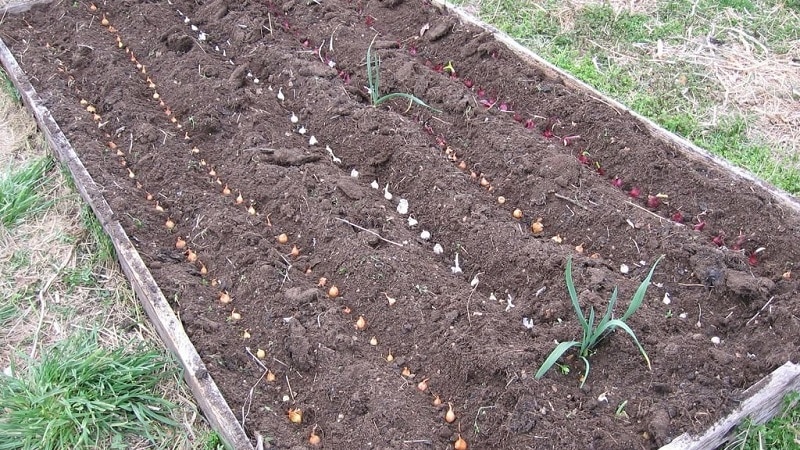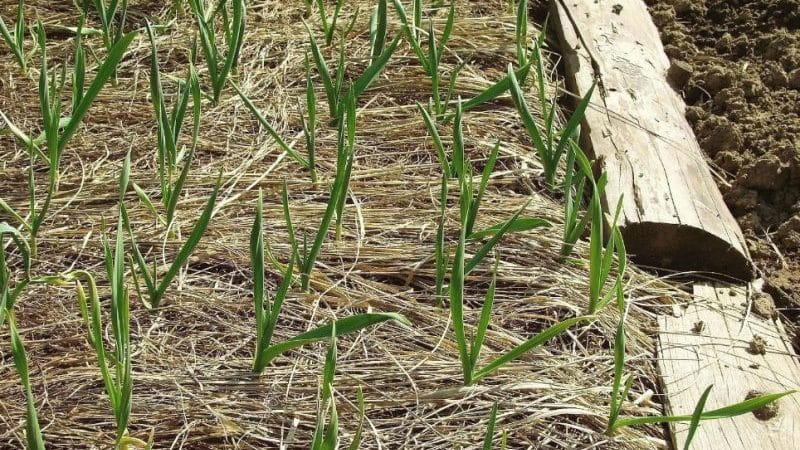We choose how to cover onions from frost for the winter and study the nuances of the process
What and how to cover onions for the winter - a question that is relevant for many summer residents. For this, both artificial materials (agrofibre, expanded clay, burlap) and organic materials (hay, sawdust, leaves, peat) are used - the latter retain heat and moisture well, and allow air and sunlight to pass through.
The article will tell you how to properly cover the plantings and what material to choose for onion beds.
Why cover onions for the winter?

Insulating winter beds will preserve crops and improve the characteristics of the future harvest. Properly sheltered plants produce early shoots. A layer of insulation not only protects from frost, but also helps the crop cope with sudden climate changes. If it suddenly gets warmer or snowfalls and frosts begin, the plantings will not be affected.
Important! Is it necessary to cover onions planted before winter in the southern regions? It is not necessary to do this here: the further north the area, the more thoroughly the plants are insulated.
Why can't you ignore this procedure?
Do I need to cover onions for the winter? The protective material creates a favorable microclimate for the growth and development of vegetables and prevents soil freezing.
The main advantages of sheltering plantings:
- when frost occurs, the onion does not freeze;
- the percentage of vegetable germination increases;
- the bulbs accumulate strength for growth and actively develop in the spring;
- weed growth slows down;
- seedlings that appear during the thaw do not die;
- the soil does not become waterlogged;
- plants are protected from pests and diseases.
When to cover the beds
Insulate or mulch the beds on the day of sowing. The timing depends on the region and weather conditions.
Important! Bulbs should take root first and not just grow.
The optimal temperature for planting crops in open ground is +10…+12°C. The procedure is carried out 2-3 weeks before the first frost.
Onion planting dates before winter:
- middle zone: from the beginning of the third ten days of September to the second ten days of October;
- northern regions, the Urals and Siberia: second ten days of September – second ten days of October;
- southern regions and Crimea: third ten days of October – first ten days of November.
How to cover onions from frost for the winter
The choice of insulation depends on many factors:
- climate in the growing region;
- winter weather forecast;
- availability of material;
- summer resident's opportunities.
Agrofibre

The material is a thin film made of propylene.
Advantages of agrofibre:
- holds heat well;
- allows sunlight to pass through;
- weighs little;
- durable, with careful use lasts for 2-3 seasons.
Flaws:
- overheating of the soil at excessive temperatures;
- the formation of condensation inside, which leads to the development of diseases.
Agrofibre is used in regions with warm winters.
Peat
Peat is an excellent natural thermal insulation material. A layer of 4 cm is sufficient for insulation.
Advantages:
- high thermal insulation properties;
- moisture retention.
Flaws:
- increases soil acidity;
- drying, compacts and forms a crust;
- difficult to reach.
Sawdust
The use of sawdust from chipboard or other building materials will negatively affect onions due to the increased content of chemicals. Therefore, clean sawdust is chosen to protect vegetables.
Advantages:
- good thermal insulation;
- perfectly absorbs and retains moisture.
Flaws:
- from excess moisture, sawdust cakes and rots;
- acidify the soil;
- in the spring they interfere with soil warming.
Leaves

Maple or oak leaves are used to insulate plantings. Fruit trees are not suitable for these purposes: they often serve as a breeding ground for diseases and pests. Birch leaves quickly rot.
Important! The material is dried before use.
Advantages:
- availability;
- high breathability;
- heat retention.
Flaws:
- difficult to prepare;
- It is important to keep the foliage dry;
- at high humidity the onions become damp;
- the material creates favorable conditions for the development of diseases and pests.
Hay

Hay is used only in dry form and must be protected from moisture.
Advantages:
- high thermal insulation;
- protection of the soil from waterlogging;
- slowing down weed growth.
Flaws:
- when wet, hay becomes very compacted and increases soil moisture;
- serves as a habitat for pests;
- With the onset of spring, under a layer of grass, the earth slowly warms up.
Sackcloth
Burlap does an excellent job as insulation. When choosing it, pay attention to the composition of the fabric: synthetics do not allow air to pass through well and do not regulate humidity.
Advantages:
- protects plantings from excess moisture;
- does not allow sunlight to pass through.
Flaws:
- the fabric dries for a long time and poorly, which contributes to damping off;
- Diseases develop under damp burlap.
Expanded clay
It is a building material made from baked clay. It is a light oval stone. Expanded clay serves as drainage, mulch and heat insulator for plants at the same time.
Advantages:
- high breathability;
- protection of plantings from getting wet, rotting, and temperature changes.
The only drawback of expanded clay is its inaccessibility.
Stems
The stems will cover the plants if nothing is at hand. To do this, take dry and healthy plant residues without seeds.
Advantages:
- availability;
- high breathability.
Flaws:
- at high humidity the stems become damp;
- putrefactive diseases develop under the layer of organic matter.
Brushwood
Brushwood does not retain heat so much as it retains snow cover. This, in turn, protects the onion from frost and wind.
Advantages:
- doesn't give a damn;
- allows air to pass through well;
- does not rot for a long time.
Brushwood does not have heat-protective properties, so it is not used in snowless winters.
Lapnik
This material is often used in forested regions where there are many branches of coniferous trees.
Advantages:
- creates an additional air gap;
- holds snow;
- repels rodents;
- keeps warm.
Flaws:
- pine needles acidify the soil;
- often serves as a breeding ground for diseases and pests.
How to do it right

The use of covering materials in combination will have a beneficial effect on the quality of the crop.
Stages of winter shelter for onions:
- After sowing, the bed is mulched with any organic matter: peat, leaves, hay, sawdust.
- To prevent the mulch from being blown away by the wind, dry branches or spruce branches are placed on top.
- In early spring, the shelter is removed. They do this as soon as the snow melts.
Useful tips
There are many options for covering winter onions, and each has advantages and disadvantages. Select the material in accordance with the climate and remember the main condition: the shelter should protect vegetables from rotting, freezing and pests.
Recommendations from experienced gardeners:
- Do not use film for covering: it is too thick and does not allow air to pass through.Due to low ventilation, condensation will accumulate, fungi will appear, and turnips will rot.
- Don't forget about crop rotation. If you plant a crop after carrots, garlic, strawberries and other onions, the pathogens and pests accumulated in the soil will destroy the entire crop.
- Follow the shelter deadlines. They depend on the time of sowing and the climatic characteristics of the region.
- Use environmentally friendly materials.
- In case of severe frosts or little snow cover, use several covering materials in combination.
This is interesting:
Why do they prune onions when planting before winter and is it necessary to do so?
High-yielding winter onion variety "Radar".
The best ways to preserve green onions for the winter at home.
Conclusion
Onions are a cold-resistant crop, but even they are important to protect in winter from winds and temperature changes. The covering material is selected taking into account the weather conditions in the growing region. If the winter is long, use foliage and brushwood together; if there is little snow, use agrofibre. Such measures increase the germination rate and quality of the crop.